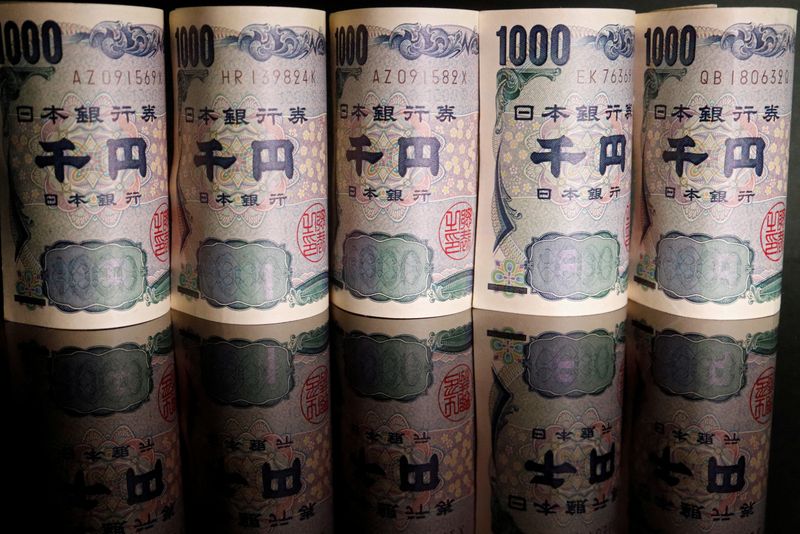By Leika Kihara
TOKYO (Reuters) - Japanese authorities are facing renewed pressure to combat a sustained depreciation in the yen, as investors eye prospects of higher-for-longer U.S. interest rates while the Bank of Japan remains wedded to its super low interest rate policy.
The Japanese yen hit a fresh one-year low of 150.50 per dollar, and was not far off the three-decade low of 151.94 it touched in October last year that led to Japanese authorities intervening in the currency market.
Below are details on how yen-buying intervention works:
LAST CONFIRMED YEN-BUYING INTERVENTION?
Japan bought yen in September of last year, its first foray in the market to boost its currency since 1998, after a Bank of Japan (BOJ) decision to maintain its ultra-loose monetary policy drove the yen as low as 145 per dollar. It intervened again in October 2022 after the yen plunged to a 32-year low of 151.94.
The yen's jump on Oct. 3 led some traders to believe Japan intervened again, although funds flow data suggest otherwise. The Ministry of Finance will release monthly intervention data on Oct. 31 that will confirm whether authorities had stepped in.
WHY STEP IN?
Yen-buying intervention is rare. Far more often the Ministry of Finance has sold yen to prevent its rise from hurting the export-reliant economy by making Japanese goods less competitive overseas.
But yen weakness is now seen as problematic, with Japanese firms having shifted production overseas and the economy heavily reliant on imports for goods ranging from fuel and raw materials to machinery parts.
WHAT HAPPENS FIRST?
When Japanese authorities escalate their verbal warnings to say they "stand ready to act decisively" against speculative moves, that is a sign intervention may be imminent.
Rate checking by the BOJ - when central bank officials call dealers and ask for buying or selling rates for the yen - is seen by traders as a possible precursor to intervention.
So far, Japanese policymakers have said only that currency rates ought to move stably reflecting fundamentals, and that excess volatility was undesirable.
STEALTH INTERVENTION
Since October last year, Japanese authorities have refrained from confirming whether they had stepped into the market. They may be relying on psychological tactics to fight yen bears.
By staying mum, authorities can keep investors guessing and discourage speculators from testing the yen's new lows - a tactic known as "stealth intervention."
LINE IN THE SAND?
Authorities say they look at the speed of yen falls, rather than levels, and whether the moves are driven by speculators, to determine whether to step into the currency market.
With the dollar having breached the psychologically important 150-yen level, many market players see 151.94 yen, where Japan last intervened, as the next threshold, then 155.
WHAT'S THE TRIGGER?
The decision is highly political. When public anger over the weak yen and a subsequent rise in the cost of living is high, that puts pressure on the administration to respond. This was the case when Tokyo intervened last year.
With his approval ratings sliding, Prime Minister Fumio Kishida announced a plan to compile a package of steps to cushion the economic blow from rising inflation.
If the yen's slide accelerates and draws the ire of media and public, the chance of intervention would rise again.
The decision would not be easy. Intervention is costly and could easily fail, given that even a large burst of yen buying would pale next to the $7.5 trillion that change hands daily in the foreign exchange market.
HOW WOULD IT WORK?
When Japan intervenes to stem yen rises, the Ministry of Finance issues short-term bills, raising yen it then sells to weaken the Japanese currency.
To support the yen, however, the authorities must tap Japan's foreign reserves for dollars to sell for yen.
In either case, the finance minister issues the order to intervene, and the BOJ executes the order as the ministry's agent.
CHALLENGES?
Yen-buying intervention is more difficult than yen-selling.
While Japan holds nearly $1.3 trillion in foreign reserves, these could be substantially eroded if Tokyo intervened heavily and repeatedly, leaving authorities constrained over how long they can defend the yen.
Japanese authorities also consider it important to seek the support of Group of Seven partners, notably the United States if the intervention involves the dollar.

Washington gave tacit approval when Japan intervened last year, reflecting recent close bilateral relations. U.S. Treasury Secretary Janet Yellen said last month the question of Washington giving the greenlight over another yen-buying intervention by Japan "depends on the details" of the situation.
Speaking after a G20 finance leaders' meeting in Marrakech earlier this month, Finance Minister Shunichi Suzuki said he told his G20 counterparts that Tokyo may need to take "appropriate action" in the exchange-rate market as global monetary tightening could heighten currency volatility.